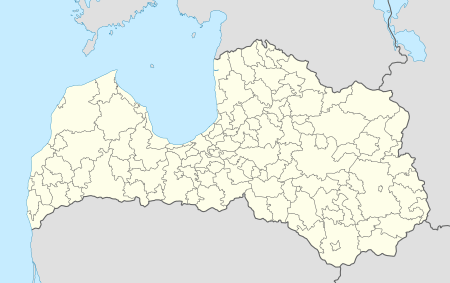Balvi
| Balvi | |||
|---|---|---|---|
| Town | |||
|
Bērzpils street in Balvi | |||
| |||
 Balvi Location in Latvia | |||
| Coordinates: 57°8′N 27°15′E / 57.133°N 27.250°ECoordinates: 57°8′N 27°15′E / 57.133°N 27.250°E | |||
| Country |
| ||
| Municipality | Balvi Municipality | ||
| Town rights | 1928 | ||
| Government | |||
| • Mayor | Jānis Trupovnieks | ||
| Area | |||
| • Total | 5.1 km2 (2.0 sq mi) | ||
| Population | |||
| • Total | 7,997 | ||
| • Density | 1,576/km2 (4,080/sq mi) | ||
| Time zone | EET (UTC+2) | ||
| • Summer (DST) | EEST (UTC+3) | ||
| Postal code | LV-4501 | ||
| Calling code | +371 645 | ||
| Number of municipal council members | 15 | ||
Balvi (![]() pronunciation ) is a town in the Latgalia region of eastern Latvia. It is the administrative seat of the region (Latvian: rajons) of the same name since 1949; prior to the occupation of Latvia it was part of the Abrene district. The name derives from the stream Bolupīte and the adjacent lake.
pronunciation ) is a town in the Latgalia region of eastern Latvia. It is the administrative seat of the region (Latvian: rajons) of the same name since 1949; prior to the occupation of Latvia it was part of the Abrene district. The name derives from the stream Bolupīte and the adjacent lake.
The first mention of Balvi was in 1224. A small wooden church and manor were constructed on the estate of a Polish noblewoman at the site ca. 1765. When Latgale came under Russian rule in 1772, the estate was granted to the Yelagin family by Catherine II. In 1806 it passed to the Horozhinsky family and in 1876 the estate was purchased by the Baltic German Transehe-Roseneck family. The village was separated from the estate in 1915, and Balvi received town rights in 1928.
Most of the town's Jews (around 21% of the population) perished in the Stahlecker phase of the Holocaust in August 1941. The retreating Germans set fire to Balvi in July 1944, and the town was rebuilt according to Soviet plans from 1945. Balvi was a center of the Singing Revolution and is vital to Latgalian culture today. The town library in particular is the focus of many cultural events.
.jpg)

